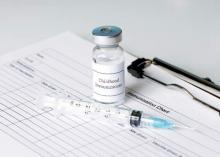To improve vaccination rates, providers need to understand what drives patients’ decisions not to comply, according to research published in Policy Insights from the Behavioral and Brain Sciences.
Adding on to data collected from the WHO–SAGE vaccine hesitancy working group, Dr. Cornelia Betsch of the University of Erfurt (Germany) and her associates argue that most patients who do not get vaccinated refuse to comply because of issues of complacency, convenience, confidence, or utility calculation – the four Cs. By using the “Four C Model,” doctors can target interventions based on the active determinants that impede vaccination:
• For complacent individuals who may not care about immunization, researchers recommend motivating patients in a way that strengthens positive attitudes toward vaccinations, stresses the social benefit of vaccines, positions vaccination as the norm, and debunks vaccination myths.
• For individuals who do not want the inconvenience of vaccine costs or travel, the researchers say interventions that support self-control and follow through can be effective, as well as asking individuals to precommit to vaccination or issuing phone and SMS appointment reminders.
• For individuals who lack confidence that vaccines can be effective (or do not trust vaccines), researchers recommend exposure to information that debunks vaccination myths and that comes from trustworthy sources, such as doctors.
• Some individuals may hesitate to be vaccinated because the information they used to calculate decisions is contradictory or incomplete. Providing additional information, such as debunking myths and stressing the social benefits of vaccines, can tip the scales toward immunization, the researchers noted.
“Even though there are policies in place, and safe and effective vaccines available, almost every country struggles with vaccine hesitancy, that is, a delay in acceptance or refusal of vaccination. Consequently, it is important to understand the determinants of individual vaccination decisions to establish effective strategies to support the success of country-specific public health policies,” the authors wrote.
They declared no potential conflicts of interest with respect to the research, authorship, and/or publication of this article.
Read the article here.


